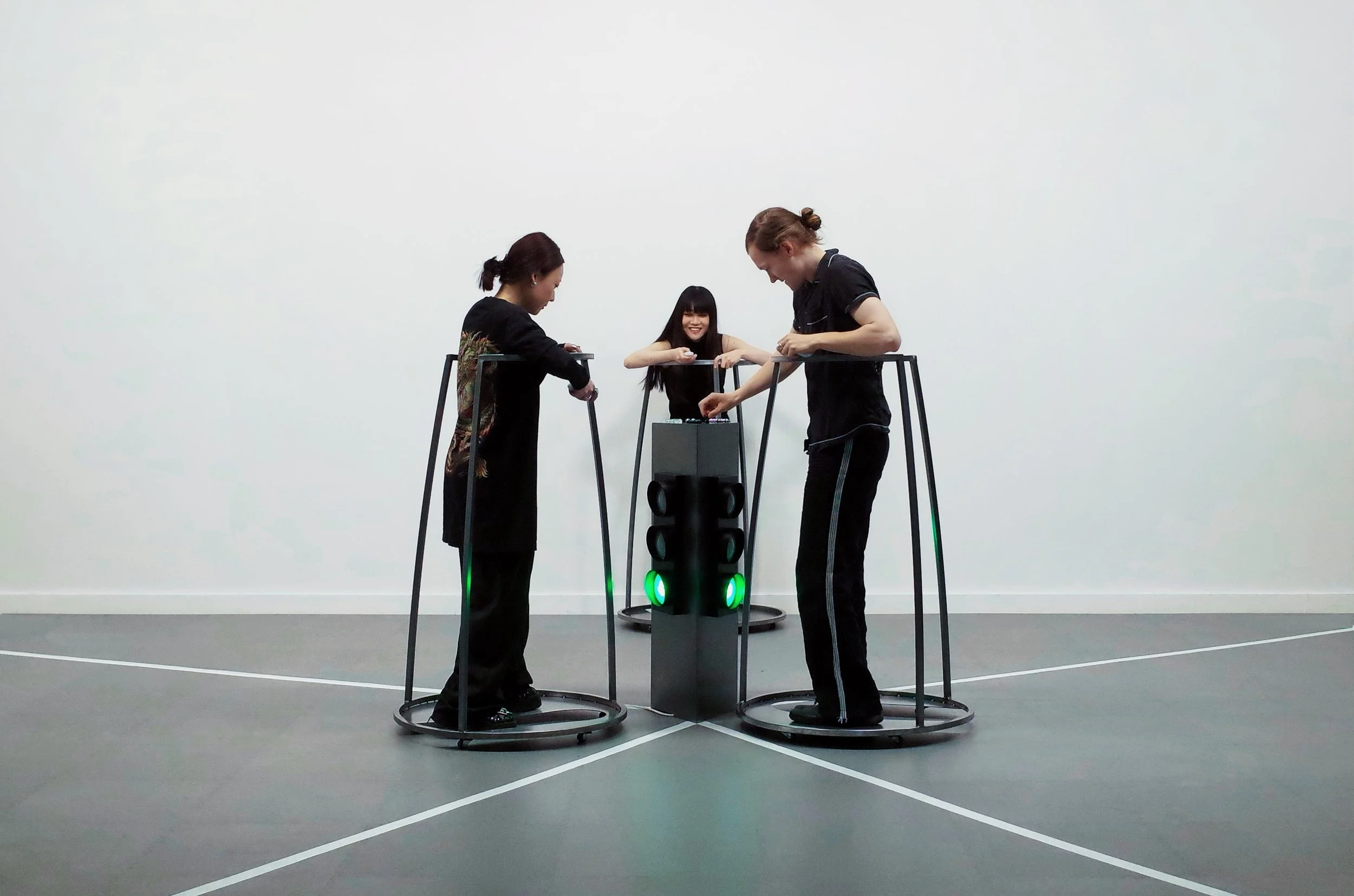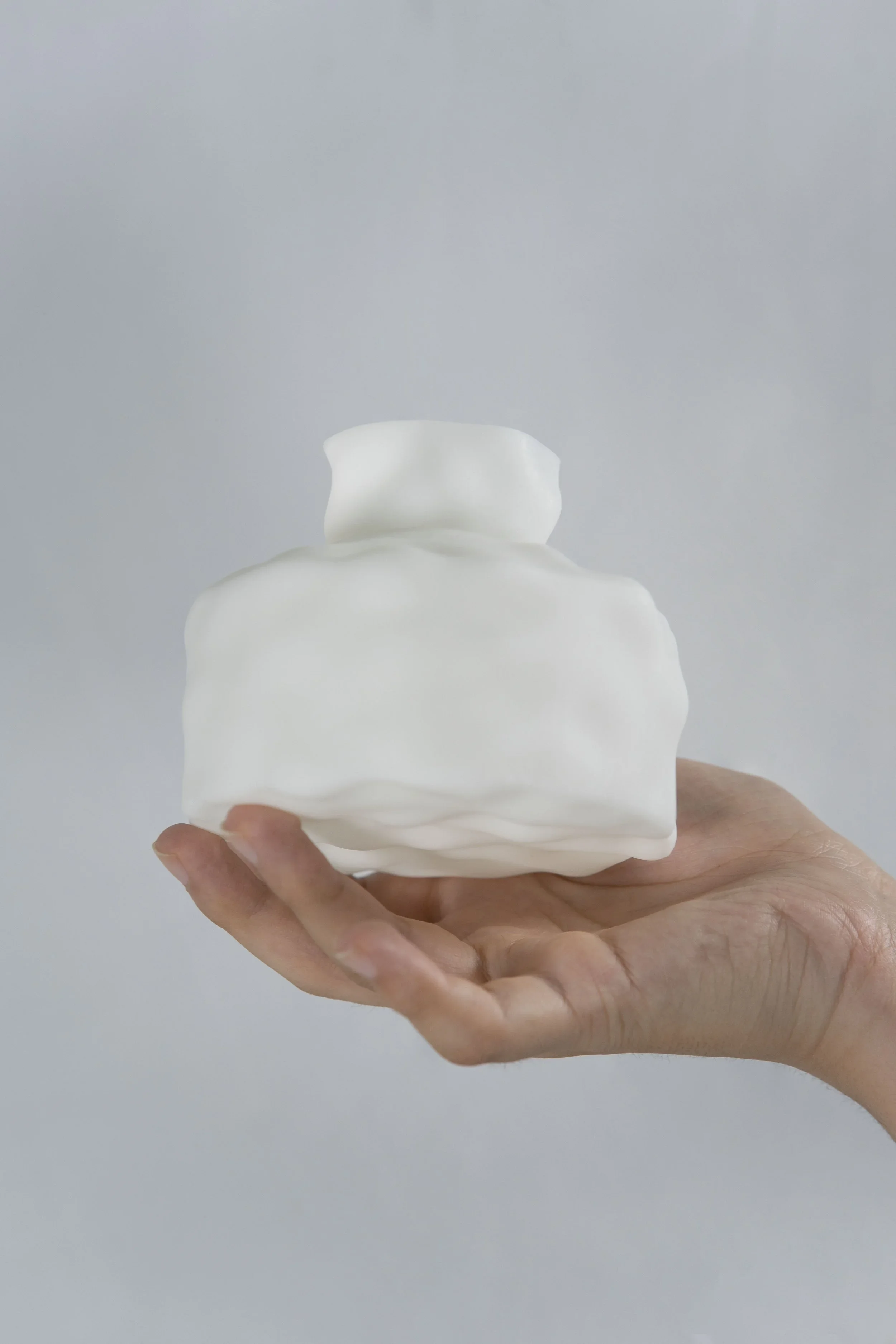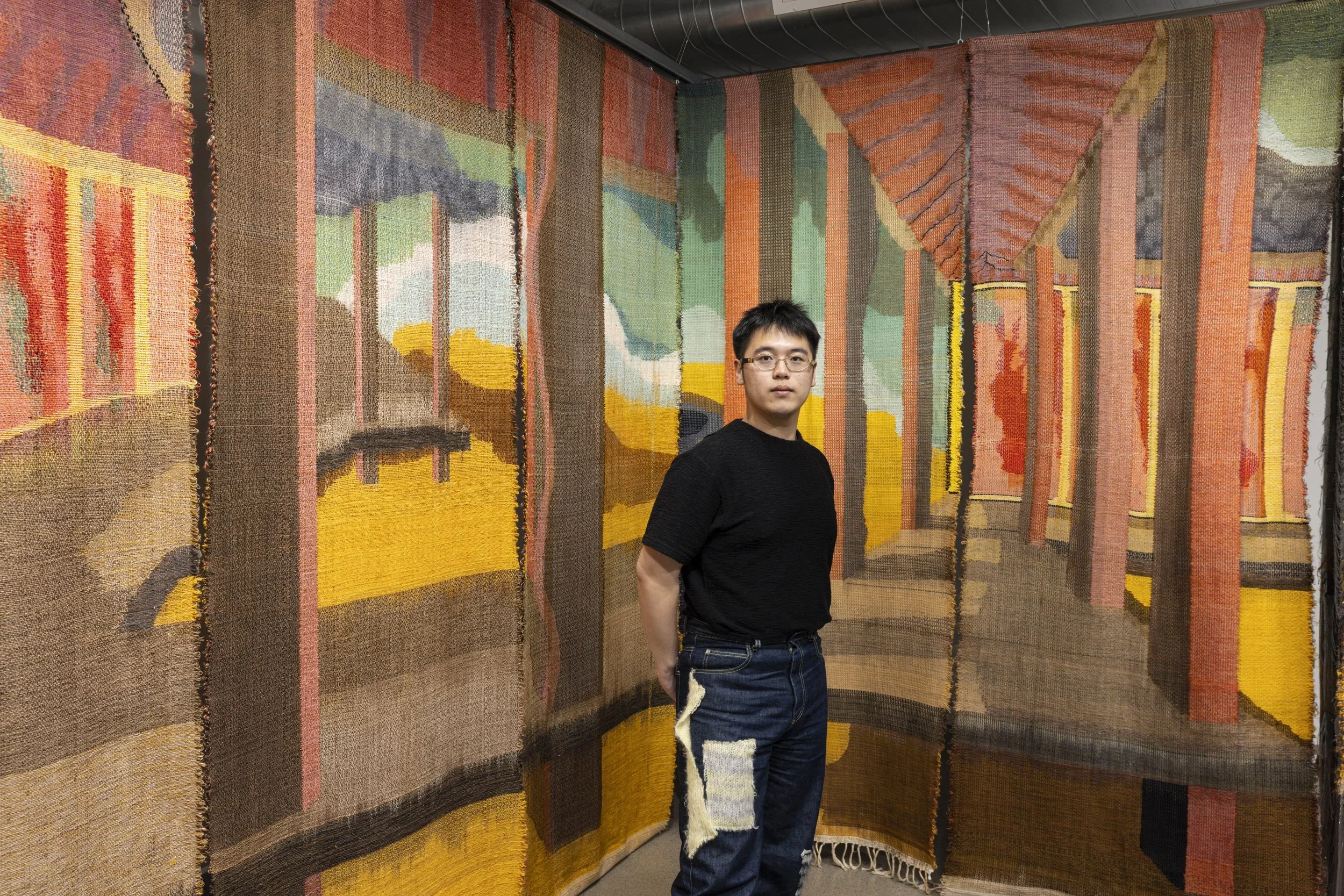10 Questions with Nadia Armouti
Nadia Armouti (she/her b. 1993) is an artist and researcher based in London, UK, and Seoul, Korea. She creates experiences that bring visibility to both self-imposed limitations and alternative pathways to personal fulfillment. By forcing her audience to make choices and then reflect on them, she invites a level of awareness to everyday decision-making and crafts her practice with an intent to thoughtfully impact each individual with personalized and lasting effects.
Armouti is currently completing an MFA at Goldsmiths, University of London.
Prior to developing her visual practice, Armouti earned a BA in Government from Harvard. She then held several management roles in Human Resources and Diversity, Equity, and Inclusion at corporate offices on three continents. The skills and experiences she has cultivated not only shape her world-view but also inform the concepts and execution of her work today.
Nadia Armouti - Portrait
ARTIST STATEMENT
Nadia Armouti is an artist-researcher creating experiences that bring visibility to both self-imposed limitations and alternative pathways to personal fulfillment. By forcing her audience to make choices and then reflect on them, she invites a level of awareness to everyday decision-making and crafts her practice with an intent to thoughtfully impact each individual with personalized and lasting effects.
A response to and extension of contemporary art discourse around alternative ways of existing in and as a society, Armouti’s practice employs direct representations of the status quo, often supplemented with organic conversational exchange with the audience, to create awareness of the unnoticed. Through her research, she asks viewers to consciously see what they are looking at, to notice the unnecessary as well as the absurd, and, perhaps most importantly, to pay attention to the choices they make without even realizing it.
Armouti sees immense power in bringing such awareness and curiosity to everyday decisions. Rather than paving the way with grand propositions, she proposes an intentional reinsertion of creativity into small daily choices to challenge complacency, counter habitus, and ultimately open our minds to new possibilities. Through her work, Armouti offers the very opportunities for intimate self-reflection and awareness-building that she believes is critical and overlooked first step on this path toward a more fulfilling future for us all.
At the core of her practice is Quotidian Creative. Experienced on-screen, in the room around you, and as a performance, Quotidian Creative flips the authority of the technology away from escaping reality toward imbuing reality with more creativity. On the surface, the game simply forces its player to make choices. However, through immersive, choice-responsive projections bringing life to the metaphor of breaking down walls and an intimate conversation with the artist in the moments that follow each choice, Armouti tempts the
player to pick at their own habitus. She tempts them to bring their beliefs, assumptions, and limitations to speech, and to come to their own conclusions about them. In doing so, she invites the player to choose between the security of the status quo and the potential of any suppressed wishes, to consider—in continuation of the metaphor—not only where they are but also where they want to be.
Armouti’s approach is greatly informed by her professional experiences. While working in human resources, she discovered how asking questions can uncover invisible structures and limits, subsequently empowering people to reach new conclusions on their own without the need for coercion or persuasion. Moreover, she observed that once people recognize their dissatisfaction with the status quo, they become curious as to whether there are alternatives. Though this approach is not designed to be therapeutic, it provides space to uncover our most authentic wishes and consider what might happen should we bring them to the forefront of our choices.
© Nadia Armouti
INTERVIEW
First of all, introduce yourself to our readers. You originally come from a non-artistic background and previously worked in HR and management roles. How did you start getting involved with art? And when did you realize you wanted to be an artist?
It's true that I have a non-traditional background, but looking back, I've always had an art practice. In the corporate spaces I inhabited, I was actively challenging the institutional constructs that we're convinced to accept as intrinsic. It was a performance- and dialogue-based practice, and it was successful. But it was also draining and a constant uphill battle.
In the midst of all this, I found myself participating in a residency on mixed media. For context, I studied abroad in college and, unbeknownst to me, had left an impression on my painting professor. Five years later, she contacted me about applying, and that residency was the turning point. Contemporary art felt like a more authentic mode of expression, of calling for change, of reaching more people. Initially, I shifted to image-making, but I've found my way back to a dialogue and relation-driven social practice, not dissimilar to the practice I started while in HR.
Your background and past experiences seem to influence your current research as an artist, at least from a conceptual perspective. How do you incorporate those experiences into your current work? And how do they shape it?
Without my experiences, my work wouldn't be. My practice is the product of everything I've learned, but it's not rooted in the things I know; it's rooted in the things I don't know. I understand that endless possibilities exist and, as a result, I developed an acute awareness and appreciation for the endless possibilities I can't fathom. My practice is fundamentally an embrace of my relentless ignorance. When people claim there's no better way of doing or approaching something, I think, how arrogant is that? To believe we are clever enough to know all that's possible and correctly characterize something as impossible? I aim to create moments of introspection to challenge such notions of impossibility, to bring awareness to the "I can'ts" of the every day, and to ask, "are you sure you can be sure?".
Clause15.5, text adventure game, dimensions variable, 2022 © Nadia Armouti
Quotidian Creative, interactive video game, installation, performance, dimensions variable, 2022 © Nadia Armouti
How would you define yourself as an artist nowadays? What aspects are you focusing on, and what are your unique characteristics?
I see myself as a socially-engaged artist-researcher. My work takes many shapes, but at its core always centers around liberation from self-imposed limitations, and I deal a lot with ideas around existential freedom. In my view, awareness is a powerful tool, so much of my work uses personal exchange—conversation—and thought experiments facilitated by interactive media to foster self-awareness. Through my practice, I try to help others excavate and prioritize their most authentic wishes. I focus on intimate and personal conceptions of what could ideally be: What is it at their core that truly matters to each person I engage with? What does the most fulfilling future look like for them? What's within their power to make that potential into a reality? We have that conversation.
I don't envision a single idealized future for everyone, but rather invite each person to imagine one for themselves. And when they've allowed themself to do so, we have a conversation about why they believe that the future is or isn't possible. It's a very personalized and open way of thinking about what the future could be, and I believe that makes my work unique.
As a research artist, how do you choose the themes and concepts you want to focus on?
My practice is always guided by a specific intent. In my own life, I'm constantly trying to maintain awareness of my choices, clutching at my freedom. I intend to spread that commitment to awareness.
Our process of choice-making intersects with every facet of life. If I can inspire others to simply avoid mindless choices, I consider my practice successful. I'm first and foremost committed to this idea, and whatever themes and concepts communicate the idea are what appear in my work. This approach gives my practice direction and purpose but still allows me flexibility to discuss what I feel is relevant or interesting or inspiring at the moment.
Quotidian Creative, interactive video game, installation, performance, dimensions variable, 2022 © Nadia Armouti
Your work is strongly relational, as it requires the direct participation of the viewers. Do you find people willing to express themselves more through their participation in artworks and performances? In other words, do you think being part of someone else's work makes it easier for people to fully express themselves?
I don't know if full expression is ever easy. Full expression is authentic expression. It requires honesty with oneself, and true awareness of who you are and what you value. Doing that in any scenario is difficult, regardless of whether you do it as part of your own work or another's. I would be surprised if adding an audience to the process of finding that expression would make it easier, but everyone is different, and we can't know what it's like for others when we aren't present.
If we take my practice, for example, what I do is intimate and direct. We have conversations about the participant's thoughts, feelings, and fears, and discuss socially charged topics with implications for how we constitute self-value. Despite assurances that there is no right answer, honesty in this context is profoundly uncomfortable for some. For those people, authentic expression through my work is challenging. I can't say whether my presence makes it more or less challenging, but it's certainly not easy.
Quotidian Creative, interactive video game, installation, performance, dimensions variable, 2022 © Nadia Armouti
Quotidian Creative, interactive video game, installation, performance, dimensions variable, 2022 © Nadia Armouti
Your statement says, "Through her research, she asks viewers to consciously see what they are looking at, to notice the unnecessary as well as the absurd, and, perhaps most importantly, to pay attention to the choices they make without even realizing." What is the response you usually get from your viewers? Do they ever give you new perspectives and inputs on your own work?
Every person is different, but a common thread is a surprise at how simple questions—"what's worth more, work or rest?"—and basic prompts—"escape the room"—can uncover underlying beliefs that manifest in even the most unassuming choices. The choice to have cereal, or eggs, or nothing at all for breakfast can have far-reaching implications regarding one's beliefs about health, the value of time, and priorities of experience. When these beliefs surface, around half of the time the participant is shocked at what the beliefs are. The other half is already aware of what's driving their choices.
That said, my practice isn't about the specific choices people make. What I find more interesting is whether they're happy with their choices once they bring awareness to them. I see this very clearly in my work, Quotidian Creative, where participants must make a series of choices to reach the end of the game. Depending on the choices one makes, various endings are possible. The player who reaches the end and wants to play again is very different from the player who reaches the end and stops playing. Regardless, each time I play with someone and discuss their choices with them, I gain new insights that enrich the context and experience for future participants. I learn something new about what my work is doing, what it's not doing, and ways to make it more generative for everyone involved.
Is there anything else you would like to experiment with?
I don't practice in a manner that contradicts my intent, so experimentation is an integral part of my practice. My work is growing and developing quickly, which means I have to be thoughtful about where I focus. Right now, I prioritize experimentation that generates a context-driven, cohesive experience for the viewer and sits both within and outside of the traditional boundaries of exhibition and gallery. Pure dialogue, object-making using relics from that dialogue, existential psychotherapy concepts, writing, appropriation of everyday content like documentaries, sleep stories, and music—all of these things have the potential to extend the value of my practice outside of the exhibition moment. I want to lean into that.
Clause15.5, zine-style game-play manual, dimensions variable, 2022 © Nadia Armouti
Clause15.5, zine-style game-play manual, dimensions variable, 2022 © Nadia Armouti
Let's talk about the art world. You are based between London and Seoul. How do you find these cities, art-wise? They are both great markets and very stimulating places. Do they influence your work?
Art-wise, the two cities are rather different. London is very experimental; it's an emerging artist's playground and home to many established artists and galleries. The broad mix makes for a fascinating art scene. Practicing in London has pushed me to remain radical about what my art could do.
Seoul's art scene is blooming, though seemingly less experimental. But context is important here: in London, I work as an artist; in Seoul, I'm a gallerist. The emphasis shifts from the making to the sharing—and the selling. Though commercial viability isn't a consideration in my practice, working as a gallerist often begets questions of accessibility. It makes me more conscious about what forms of art are far-reaching. An art object may not be as accessible as an everyday object, but it's certainly more accessible than an intangible experience.
I find the hybrid role I play creates a symbiotic tension between possibility and practicality that's helpful as both artist and gallerist.
Clause15.5, zine-style game-play manual, dimensions variable, 2022 © Nadia Armouti
How do you promote your work? And how do you keep your collectors and followers engaged?
Promotion is something I believe has to make sense for the individual. I have the standard website and Instagram account, but I don't create extra content for the sake of gaining traffic. I share for myself and for the people who know and support my work. It's a sort of memorialization of that moment in my practice.
My strength is relationships; the best way for me to gain exposure is to cultivate genuine personal relationships. There's a Berlin-based gallery, neugerriemschneider, that has no online presence. Their business model has always been based on real-life relationships. I think that's delightful! While I don't wish to emulate zero online presence, I've organically met many wonderful individuals—often gallerists—through my work in Seoul. They occasionally become curious about my practice. I've gotten my art in front of several generous and helpful people that way. It's true to my practice, and it's working for me so far.
And lastly, what are your plans for the future? Are you working on any new projects, or do you have any upcoming exhibitions?
The next year will be a bit of a whirlwind. I'm part of a virtual group exhibition on the theme of mental health opening in October, called Zealous Amplify, where I'll be showing an ongoing body of work, Quotidian Creative. It's an immersive video game installation and interactive performance. But after this show, I want to focus on the final year of my MFA at Goldsmiths. I'm starting a new body of work that I expect to have a robust research component, more in the school of Helina Metaferia or Suzanne Lacy. This work will center on dialogue, trust, introspection, and existential freedom, as a context-giving extension of Quotidian Creative in all directions. I'll be showing this new work together with Quotidian Creative at my degree show in July. Until then, I'll concentrate on making the work the best it can be.

























